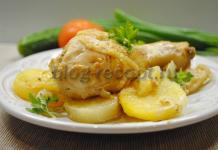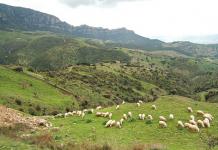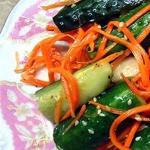In some countries such a magnificent variety of meat as lamb is considered a real delicacy. It produces delicious dishes, including various national cuisines of peoples for whom lamb is considered a national product. People who are accustomed to monitoring the energy value of food and eating only healthy foods, in most cases prefer to use lamb in their diet because of its nutritional value and dietary properties.
This article will help you understand how many calories are in lamb and what positive effects it can have on the human body.
Lamb composition, vitamins, dietary and beneficial properties
 The main thing this type of meat contains is easily digestible proteins., which allow the body to obtain amino acids important for maintaining health. Lamb contains sodium, phosphorus, magnesium, potassium, as well as vitamins PP, B2, B1.
The main thing this type of meat contains is easily digestible proteins., which allow the body to obtain amino acids important for maintaining health. Lamb contains sodium, phosphorus, magnesium, potassium, as well as vitamins PP, B2, B1.
The consumption of this meat in its pure form should be limited if a person has severe problems with the stomach or intestines, since the meat is considered difficult to digest, but despite this, Eastern medicine unconditionally asserts that this particular meat is considered the best for humans. The daily norm of lamb meat is 50 grams.
Meat of this variety contains almost three times less fat compared to pork, and two and a half times less than that found in beef. That is why doctors insist on eating lamb during the diet. It is worth noting that lamb fat is also used in the treatment of influenza, sore throats and viral infections. In this case, fat and honey are added to hot milk. Another important advantage of this meat is that it does not contain cholesterol, and it also contains cholesterol, which stimulates the functions of the pancreas and normalizes the process of cholesterol metabolism. This reduces the likelihood of a person developing atherosclerosis.
By including such meat in your diet, you can significantly reduce the likelihood of cardiovascular diseases, and broths from this meat have a positive effect on the digestive system of those people who are susceptible to gastritis.
In addition to this, eating this meat has the following effects on the body:

Calories and nutritional value
 In addition to the composition of vitamins, various chemical elements The calorie content of the product is also important. In its pure form, the calorie content of lamb is 203 kcal per 100 grams of product, but with different heat treatments and serving methods, the calorie content of the dish in its pure form tends to change. So, for example, in 100 grams of lamb:
In addition to the composition of vitamins, various chemical elements The calorie content of the product is also important. In its pure form, the calorie content of lamb is 203 kcal per 100 grams of product, but with different heat treatments and serving methods, the calorie content of the dish in its pure form tends to change. So, for example, in 100 grams of lamb:
- boiled – 291.0 calories;
- baked – 232.0 calories;
- stewed – 268.0 calories;
- fried – 320.0 calories;
- grilled - 264.0 calories.
If we talk about the nutritional value of lamb (bzhu), then with the help of a visual table you can understand what the body is saturated with when eating a dish prepared by various methods of heat treatment.
Eating lamb meat for weight loss
To normalize the body's metabolism, which contributes to weight loss, you simply need to reduce the calorie content of the foods you consume. In order for the process of ridding the body of excess fat deposits to be started, you should not torture yourself with strict mono-diets of tasteless foods, you should just replace your usual foods with foods that contain fewer calories and do not overeat, especially in the evening.
When putting their body in order, many consciously refuse to eat meat, but you can simply replace it with dietary lamb, which can saturate the body with useful elements without harming the figure. For this approach, meat from the back of the carcass is best suited, since it contains the least fat deposits, but at the same time the content of nutrients and vitamins is higher. For weight loss, it is best to use boiling, as well as boil broths or serve lamb baked in the oven, but it is better to avoid fried lamb when losing weight, due to its high fat content.
The consumption of lamb has been described since ancient times. It is especially valued in the national cuisines of the peoples of the East. It is the basis for world-famous beshbarmak, shurpa, manti, pilaf and shish kebab. Thanks to its remarkable nutritional properties, it is widely used in modern cuisine for preparing a wide variety of soups and broths; it is also baked and fried on the grill and grill. The calorie content of lamb is relatively low - only 202.9 kcal per 100 g.
Dietary features of meat
Lamb is endowed with excellent culinary and nutritional properties due to its composition. It is rich in especially easily digestible proteins and various microelements. It contains a lot of potassium, sodium, calcium, magnesium and phosphorus. It is rich in vitamins B1, B2 and PP. However, if there are approximately the same amount of minerals and vitamins in lamb as in beef and pork, then in terms of the amount of iron it exceeds them by a third.
Lamb is healthier and lower in calories compared to lamb.
This meat is difficult to digest. Therefore, its use should be limited to people prone to digestive problems. However, even despite this, Eastern doctors recognize lamb as the healthiest of all types of meat.
Lamb meat is 3 times lower in fat content than pork meat and 2.5 times lower than beef meat. Therefore, dishes made from boiled lean lamb are often included in dietary menus.
Beneficial properties of lamb
But lamb fat can also provide benefits to the body. For example, it is often used as one of the components of a remedy for sore throat, flu, ARVI and other colds. It is consumed hot.
To prepare such a remedy, dilute the following in well-heated milk:
- 1 tbsp. l. honey;
- 1 tbsp. l lamb fat.
This meat has virtually no cholesterol, but contains lecithin, which has an additional stimulating effect on the pancreas and helps break down cholesterol plaques. Thanks to this, metabolic processes in the body are normalized, which significantly reduces the risk of developing atherosclerosis.
Advice from nutritionist Irina Shilina
Pay attention to the latest weight loss method. Suitable for those for whom sports activities are contraindicated.
In addition, systematic consumption of this meat is a good prevention of heart disease, blood vessels and diabetes. This will be facilitated by the presence of sodium, magnesium, potassium salts and iron, and iodine helps normalize the functioning of the thyroid gland.
Broths made with this meat will be very useful for those who suffer from hypoacid gastritis (with reduced secretory function). A significant fluoride content will help prevent the risk of dental caries. However, you should use it very carefully if you have stomach and intestinal diseases (lamb fat is the most refractory and difficult to digest).
Losing weight representatives of the fair sex often neglect this valuable source of protein and minerals due to the specific smell. However, it can be easily removed by simply treating the meat with lemon juice or soy sauce with spices and herbs. And fresh lemon juice is added to the soup at the end of cooking the meat.
Lamb products for weight loss
In order to remove extra pounds from the waist, abdomen and hips, the best option would be to reduce your daily caloric intake. And to do this, you don’t need to renounce traditional, favorite dishes and limit yourself to strict diets. It will be sufficient to simply replace high-calorie foods with less energy-intensive ones.
However, many girls completely refuse meat products, considering them too high in calories. This strategy will not be beneficial, but if you replace regular types of meat with dietary lamb, your weight will return to normal and your body will not lack protein. Moreover, if you definitely decide to get rid of those annoying extra pounds, preference should be given to meat from the back of the animal, which contains significantly less fat and the maximum amount of nutrients, minerals and vitamins.
The method of preparation is also important, because even the most dietary product cooked in fat will lose its beneficial qualities and will only increase fat deposits. The best way to cook meat for weight loss is boiling. Moreover, properly boiled lamb has no odor, has a pleasant taste, has the lowest calorie content and retains almost all its beneficial qualities.
Different varieties of this meat can be cooked in the oven, on the grill or on the grill, but you should not use oil when frying, which significantly increases the calorie content of lamb. Naturally, there is no “lamb” diet, since this product itself does not imply significant weight loss from its use. But if you don’t discount the low calorie content of lamb, it will be an excellent substitute for boiled, stewed and baked pork or beef, and it contains more than enough useful substances.
There is definitely a point in using this product with the goal of losing weight.
CHEMICAL COMPOSITION AND NUTRITIONAL ANALYSIS
Nutritional value and chemical composition "Lamb [PRODUCT REMOVED]".
The table shows the nutritional content (calories, proteins, fats, carbohydrates, vitamins and minerals) per 100 grams of edible portion.
| Nutrient | Quantity | Norm** | % of the norm in 100 g | % of the norm in 100 kcal | 100% normal |
| Calorie content | 202.9 kcal | 1684 kcal | 12% | 5.9% | 830 g |
| Squirrels | 16.3 g | 76 g | 21.4% | 10.5% | 466 g |
| Fats | 15.3 g | 56 g | 27.3% | 13.5% | 366 g |
| Water | 67.6 g | 2273 g | 3% | 1.5% | 3362 g |
| Ash | 0.8 g | ~ | |||
| Vitamins | |||||
| Vitamin B1, thiamine | 0.08 mg | 1.5 mg | 5.3% | 2.6% | 1875 |
| Vitamin B2, riboflavin | 0.1 mg | 1.8 mg | 5.6% | 2.8% | 1800 g |
| Vitamin B4, choline | 70 mg | 500 mg | 14% | 6.9% | 714 g |
| Vitamin B5, pantothenic | 0.5 mg | 5 mg | 10% | 4.9% | 1000 g |
| Vitamin B6, pyridoxine | 0.4 mg | 2 mg | 20% | 9.9% | 500 g |
| Vitamin B9, folates | 8 mcg | 400 mcg | 2% | 1% | 5000 g |
| Vitamin B12, cobalamin | 2 mcg | 3 mcg | 66.7% | 32.9% | 150 g |
| Vitamin E, alpha tocopherol, TE | 0.5 mg | 15 mg | 3.3% | 1.6% | 3000 g |
| Vitamin H, biotin | 3 mcg | 50 mcg | 6% | 3% | 1667 g |
| Vitamin RR, NE | 5.2058 mg | 20 mg | 26% | 12.8% | 384 g |
| Niacin | 2.5 mg | ~ | |||
| Macronutrients | |||||
| Potassium, K | 270 mg | 2500 mg | 10.8% | 5.3% | 926 g |
| Calcium, Ca | 3 mg | 1000 mg | 0.3% | 0.1% | 33333 g |
| Magnesium, Mg | 18 mg | 400 mg | 4.5% | 2.2% | 2222 g |
| Sodium, Na | 80 mg | 1300 mg | 6.2% | 3.1% | 1625 g |
| Sera, S | 230 mg | 1000 mg | 23% | 11.3% | 435 g |
| Phosphorus, Ph | 178 mg | 800 mg | 22.3% | 11% | 449 g |
| Chlorine, Cl | 60 mg | 2300 mg | 2.6% | 1.3% | 3833 g |
| Microelements | |||||
| Iron, Fe | 2 mg | 18 mg | 11.1% | 5.5% | 900 g |
| Iodine, I | 7 mcg | 150 mcg | 4.7% | 2.3% | 2143 g |
| Cobalt, Co | 7 mcg | 10 mcg | 70% | 34.5% | 143 g |
| Manganese, Mn | 0.035 mg | 2 mg | 1.8% | 0.9% | 5714 g |
| Copper, Cu | 180 mcg | 1000 mcg | 18% | 8.9% | 556 g |
| Molybdenum, Mo | 12 mcg | 70 mcg | 17.1% | 8.4% | 583 g |
| Nickel, Ni | 10 mcg | ~ | |||
| Tin, Sn | 75 mcg | ~ | |||
| Fluorine, F | 63 mcg | 4000 mcg | 1.6% | 0.8% | 6349 g |
| Chromium, Cr | 10 mcg | 50 mcg | 20% | 9.9% | 500 g |
| Zinc, Zn | 3 mg | 12 mg | 25% | 12.3% | 400 g |
Energy value Lamb [PRODUCT REMOVED] is 202.9 kcal.
Main source: Product removed. .
** This table shows the average levels of vitamins and minerals for an adult. If you want to know the norms taking into account your gender, age and other factors, then use the My Healthy Diet app.
Product calculator
The nutritional value
Serving Size (g)
NUTRIENT BALANCE
Most foods may not contain the full range of vitamins and minerals. Therefore, it is important to eat a variety of foods to meet the body's needs for vitamins and minerals.
Product calorie analysis
SHARE OF BZHU IN CALORIES
Ratio of proteins, fats and carbohydrates:
Knowing the contribution of proteins, fats and carbohydrates to calorie content, you can understand how well a product or diet meets the standards of a healthy diet or the requirements of a certain diet. For example, the US and Russian Departments of Health recommend 10-12% of calories come from protein, 30% from fat and 58-60% from carbohydrates. The Atkins diet recommends low carbohydrate intake, although other diets focus on low fat intake.
If more energy is expended than it is received, the body begins to use up fat reserves, and body weight decreases.
Try filling out your food diary right now without registration.
Find out your additional calorie expenditure for training and get updated recommendations absolutely free.
DATE FOR ACHIEVEMENT OF THE GOAL
BENEFITS OF LAMB [PRODUCT REMOVED]
Lamb [PRODUCT REMOVED] rich in vitamins and minerals such as: choline - 14%, vitamin B6 - 20%, vitamin B12 - 66.7%, vitamin PP - 26%, phosphorus - 22.3%, iron - 11.1%, cobalt - 70 %, copper - 18%, molybdenum - 17.1%, chromium - 20%, zinc - 25%
Benefits of Lamb [PRODUCT REMOVED]
- Kholin is part of lecithin, plays a role in the synthesis and metabolism of phospholipids in the liver, is a source of free methyl groups, and acts as a lipotropic factor.
- Vitamin B6 participates in maintaining the immune response, processes of inhibition and excitation in the central nervous system, in the transformation of amino acids, the metabolism of tryptophan, lipids and nucleic acids, promotes the normal formation of red blood cells, maintaining normal levels of homocysteine in the blood. Insufficient intake of vitamin B6 is accompanied by decreased appetite, impaired skin condition, and the development of homocysteinemia and anemia.
- Vitamin B12 plays an important role in the metabolism and transformation of amino acids. Folate and vitamin B12 are interconnected vitamins that are involved in hematopoiesis. A lack of vitamin B12 leads to the development of partial or secondary folate deficiency, as well as anemia, leukopenia, and thrombocytopenia.
- Vitamin PP participates in redox reactions of energy metabolism. Insufficient vitamin intake is accompanied by disruption of the normal condition of the skin, gastrointestinal tract and nervous system.
- Phosphorus takes part in many physiological processes, including energy metabolism, regulates acid-base balance, is part of phospholipids, nucleotides and nucleic acids, and is necessary for the mineralization of bones and teeth. Deficiency leads to anorexia, anemia, and rickets.
- Iron is part of proteins of various functions, including enzymes. Participates in the transport of electrons and oxygen, ensures the occurrence of redox reactions and activation of peroxidation. Insufficient consumption leads to hypochromic anemia, myoglobin deficiency atony of skeletal muscles, increased fatigue, myocardiopathy, and atrophic gastritis.
- Cobalt is part of vitamin B12. Activates enzymes of fatty acid metabolism and folic acid metabolism.
- Copper is part of enzymes that have redox activity and are involved in iron metabolism, stimulates the absorption of proteins and carbohydrates. Participates in the processes of providing oxygen to the tissues of the human body. Deficiency is manifested by disturbances in the formation of the cardiovascular system and skeleton, and the development of connective tissue dysplasia.
- Molybdenum is a cofactor for many enzymes that ensure the metabolism of sulfur-containing amino acids, purines and pyrimidines.
- Chromium participates in the regulation of blood glucose levels, enhancing the effect of insulin. Deficiency leads to decreased glucose tolerance.
- Zinc is part of more than 300 enzymes, participates in the processes of synthesis and breakdown of carbohydrates, proteins, fats, nucleic acids and in the regulation of the expression of a number of genes. Insufficient consumption leads to anemia, secondary immunodeficiency, liver cirrhosis, sexual dysfunction, and the presence of fetal malformations. Research in recent years has revealed the ability of high doses of zinc to disrupt the absorption of copper and thereby contribute to the development of anemia.
You can see a complete directory of the most useful products in the appendix - a set of properties of a food product, the presence of which satisfies a person’s physiological needs for the necessary substances and energy.
Vitamins, organic substances required in small quantities in the diet of both humans and most vertebrates. Vitamin synthesis is usually carried out by plants, not animals. A person's daily requirement for vitamins is only a few milligrams or micrograms. Unlike inorganic substances, vitamins are destroyed by strong heat. Many vitamins are unstable and are “lost” during cooking or food processing.
Mutton is the meat of a slaughtered ram, lamb or sheep. Moreover, not just any sheep’s meat can be eaten. The most delicious, tender and low-calorie meat is lamb meat, especially that which was fed only on mother’s milk.
But it is advisable to slaughter adult animals before they reach two years of age, then there is still a chance to get tasty, nutritious meat. In older individuals, the meat will be tough, with an unpleasant specific odor.
Among other types of meat, lamb is considered the lowest in calories and the healthiest in its composition.
For example, it contains almost 30% less fat than pork. But it is much richer in iron content than other types of meat.
Benefit
A conclusion about the beneficial properties of lamb can be made by looking at what vitamins and microelements are included in its composition. These are almost all the main useful substances - B vitamins, calcium, iron, magnesium, potassium, iodine, fluorine, phosphorus and others.
Lamb also contains a large amount of easily digestible proteins, which makes this meat especially nutritious.
The amount of fat in this meat is even lower than protein, and therefore it practically does not contain cholesterol that is harmful to the human body.
At the same time, lamb is quite low in calories. Especially young lamb meat, which can contain only 135 calories. Therefore, this food product can rightfully be called dietary. And it deserves the attention of those people who care about proper nutrition.
Iron-rich lamb will be useful for people with low hemoglobin levels and iron deficiency anemia; it has a good effect on blood composition.
It has a beneficial effect on the condition of teeth, and can even help prevent caries. After all, it contains a sufficient amount of fluoride, which is beneficial for dental tissue.
It is good to eat lamb meat for people with pancreatic diseases. It regulates the production of gastric juice and can prevent the serious disease diabetes mellitus.
Since the meat itself is a rather heavy product, people with diseases of the gastrointestinal tract can use broths made from it. So, lamb broth will be useful for gastritis and low acidity.
If other types of meat are not harmless for people with poor vascular condition and atherosclerosis, then lamb is even useful. It is allowed to eat it in moderation. It is better if it is young lamb meat, because it has very little cholesterol.
Potassium, sodium and magnesium contained in lamb have a beneficial effect on the cardiovascular system, so this meat is useful for people with heart disease.
This meat has several other unusual beneficial properties. For example, burnt lamb is useful for scorpion or snake bites. It will help prevent the poison from spreading into the human body.
But lamb with wine will help with rabid dog bites, preventing harmful effects on humans.
Rich in protein, B vitamins and various macro- and microelements, this product, when consumed regularly but in moderation, has a beneficial effect on the condition of the skin, hair and nails. But it is not used in cosmetology.
Harm
Without undue modesty, lamb can be called a highly nutritious product. It contains a large amount of proteins and fats, which cover almost a third of the daily requirement.
| Nutrient | Daily norm/g | Quantity per 100 g of product | Percentage of Daily Value |
| Squirrels | 81 | 16,3 | 20,1 |
| Fats | 54 | 15,3 | 28,3 |
| Carbohydrates | 202 | 0 | 0 |
| Saturated fatty acids | 12 | 9 | 75 |
| Monounsaturated fatty acids | 25 | 9 | 36 |
| Polyunsaturated fatty acids | 2 | 1,5 | 75 |
Vitamins and minerals
Types and amounts of vitamins contained in 100 grams of lamb:
| Vitamin and its chemical name | Contents per 100 g of product | |
| A (carotene (retinol)) | 0 | 0 |
| B1 (thiamine) | 0.08 mg | 5,3 |
| B2 (riboflavin) | 0.1 mg | 5,6 |
| B5 (pantothenic acid) | 0.5 mg | 10 |
| B6 (pyridoxine) | 0.4 mg | 20 |
| B9 (folic acid) | 8 mg | 2 |
| B12 (cobalamins) | 2 mg | 66,7 |
| C (ascorbic acid) | 0 | 0 |
| D (calciferol) | 0 | 0 |
| E (tocopherol) | 0.5 mg | 3,3 |
| N (biotin) | 3 mg | 6 |
| K (phylloquinone) | 0 | 0 |
| R (rutin) | 0 | 0 |
| PP (nicotinic acid) | 5.2058 mg | 26 |
| L (motilmothionine) | 0 | 0 |
It is rare to find a product with such a rich content of B vitamins and nicotinic acid as lamb.
Types and amounts of macro- and microelements contained in 100 grams of lamb:
| Type of trace element | Contents per 100 g of product | Percentage of Recommended Daily Allowance |
| Bor | 0 | 0 |
| Vanadium | 0 | 0 |
| Iron | 2 mg | 11,1 |
| Iodine | 7 mg | 4,7 |
| Potassium | 270 mg | 10,8 |
| Calcium | 3 mg | 0,3 |
| Cobalt | 7 mg | 70 |
| Silicon | 0 | 0 |
| Magnesium | 18 mg | 4,5 |
| Manganese | 0.035 mg | 1,8 |
| Copper | 180 mg | 18 |
| Molybdenum | 12 | 17,1 |
| Sodium | 80 mg | 6,2 |
| Selenium | 0 | 0 |
| Sulfur | 230 mg | 23 |
| Phosphorus | 178 mg | 22,3 |
| Fluorine | 63 mg | 1,6 |
| Chlorine | 60 mg | 2,6 |
| Cholesterol | 0 | 0 |
| Kholin | 70 | 14 |
| Chromium | 10 | 20 |
| Zinc | 3 mg | 25 |
From the table data we see how rich lamb is in cobalt, iron, phosphorus, zinc, chromium, potassium and other elements. In addition, it contains almost all useful substances, even in smaller quantities.
Everything about the benefits of lamb meat becomes clear; you just have to see its chemical composition and find out the nutritional value. But this product should not be abused, since it is quite difficult to digest, and its waste is eliminated from the body for quite a long time.
Lamb is a selected type of meat, which is considered a delicacy in many countries around the world. Dishes prepared from it are always of impeccable quality and excellent taste. For many, lamb is a national product, on the basis of which hundreds of traditional dishes are prepared. People who monitor their diet and take into account not only the energy value, but also the beneficial qualities of the product, are accustomed to seeing lamb on their table. This type of meat is very popular due to its dietary properties.

Energy value
In any product, its composition is valued, or, more precisely, the presence of vitamins and beneficial microelements. Also, do not forget about the nutritional value of the product, that is, about the concentration of proteins, fats and carbohydrates in it.
This table contains information on BJU per hundred grams of meat prepared in various ways.



In the cuisine of many eastern countries, lamb takes first place in frequency of use. Well-known dishes are prepared from it, such as manti, various shurpa-type soups, pilaf and, of course, delicious shashlik made from the pulp. And that's not all. To this day, a tradition has been preserved in which a whole lamb is roasted on the occasion of a significant event.
As for the KBJU product, the energy value of 100 grams of fresh lamb is 209 kcal. Just like BJU, calorie content can change with different options for preparing the product.



Changes in calorie content with different types of heat treatment of lamb leg.
Processing methods | |
Lamb heart is considered the leanest option: it contains only 82 kcal per hundred grams. The tongue is also very useful (it contains 195 kcal), the ribs contain 203 kcal, but they are still considered dietary compared to other parts of lamb, because the shoulder has 380 kcal, the back has 460 kcal, and the breast has 533 kcal.


Benefits and harms
Among the various types of lamb, Kalmyk sheep meat stands out, which is considered more useful than other varieties. It does not have a specific smell, but it contains an order of magnitude more useful vitamins and chemical elements than the meat of other sheep breeds.
Lamb is very rich in vitamins D, E, K, B1, B12, B2, B9, B5, B6, PP. It also contains minerals such as iron, phosphorus, manganese, sodium, magnesium, potassium, silicon, selenium, nickel, fluorine, calcium, cobalt, tin, zinc, iodine, molybdenum, chlorine, chromium, sulfur and copper. Due to the large amount of iron, lamb is recommended to be eaten for anemia and low hemoglobin levels. This type of meat stimulates the pancreas well and prevents the development of diabetes.

But even such a healthy product as lamb should not be consumed if you have problems with the kidneys, gall bladder and liver. Due to the fairly high fat content, complications are possible, so doctors recommend limiting the consumption of this product. Lamb is also contraindicated in case of impaired digestion and the following diseases:
- arthritis;
- ulcer;
- gastritis;
- heart problems;
- increased stomach acidity.

If you abuse lamb, these diseases can progress, because this meat contains a large amount of cholesterol. Lamb is also not recommended for children and the elderly. In addition, even a healthy adult is better off not eating it every day, as this can lead to atherosclerosis.
In addition to lamb, another type of meat should be present in a person’s complete diet. Otherwise, if you consume lamb exclusively, this will lead to its negative effects on the body. Studies have shown that lamb meat contains virtually no iodine, which leads to problems with the thyroid gland.

Lamb meat contains quickly digestible proteins that saturate the human body with amino acids. But, despite all the beneficial properties, this meat takes a very long time to digest and is considered heavy food. Although, according to oriental medicine, lamb is the most acceptable type of meat for humans, and you need to eat fifty grams of this product in any form per day.
For those watching their figure, there is no better meat, because its calorie content is half that of beef and about three times less than that of pork. Doctors strongly recommend replacing any meat with lamb during the dietary period. Do not forget that it is lamb fat that helps with influenza, viral and infectious diseases.

Regular consumption of lamb has the following effects on the human body:
- prevention of diabetes mellitus;
- stimulation of the proper functioning of the pancreas;
- strengthening tooth enamel and preventing caries due to the high fluoride content;
- cleansing and restoration of the cardiovascular system;
- a high concentration of iron has a positive effect on hematopoiesis.

Dietary product
In pursuit of a slim body, meat is sometimes completely excluded from the diet, but the only thing worth doing is replacing it with lamb. Naturally, eating red meat does not guarantee weight loss, because no one has heard of the “lamb” diet, but by replacing pork or beef with lamb, you can significantly reduce your daily calorie intake.
For information on how to cook lamb shoulder with potatoes in the oven, see below.


















